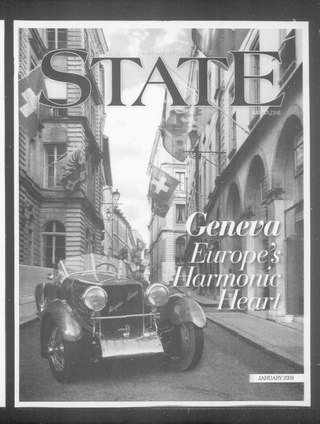
A magazine is a periodical publication, generally published on a regular schedule, containing a variety of content. They are generally financed by advertising, purchase price, prepaid subscriptions, or by a combination of the three.

The Armenian Catholic Church is an Eastern Catholic particular churches sui iuris of the Catholic Church. It accepts the leadership of the bishop of Rome, and is therefore in full communion with the universal Catholic Church, including the Latin Church and the 22 other Eastern Catholic Churches. The Armenian Catholic Church is regulated by Eastern canon law, summed up in the Code of Canons of the Eastern Churches.
Masis, Massis, or MASIS may refer to:

The Social Democrat Hunchakian Party (SDHP), is the oldest continuously-operating Armenian political party, founded in 1887 by a group of students in Geneva, Switzerland. It was the first socialist party to operate in the Ottoman Empire and in Iran, then known as Persia. Among its founders were Avetis Nazarbekian, Mariam Vardanian, Gevorg Gharadjian, Ruben Khan-Azat, Christopher Ohanian, Gabriel Kafian and Manuel Manuelian. Its original goal was attaining Armenia's independence from the Ottoman Empire during the Armenian national liberation movement.
The Armenians in Lebanon are Lebanese citizens of Armenian descent. There has been an Armenian presence in Lebanon for centuries. According to Minority Rights Group International, there are 156,000 Armenians in Lebanon, around 4% of the population. Prior to the Lebanese Civil War, the number was higher, but the community lost a portion of its population to emigration. After surviving the Armenian genocide, and initially settling in shanty towns in Lebanon, the Armenian population gradually grew and expanded until Beirut became a center of Armenian culture. The Armenians became one of Lebanon’s most prominent and productive communities.
Homenetmen is a pan-Armenian diaspora organization devoted to sport and scouting. The motto of Homenetmen is "Rise and Raise".

The Armenian Catholicosate of the Great House of Cilicia is an autocephalous Oriental Orthodox church. Since 1930, the Catholicosate of the Great House of Cilicia has been headquartered in Antelias, Lebanon. Aram I is the Catholicos of Cilicia since 1995.
The Reporter may refer to:
Spurk is an Armenian literary and public weekly, periodical, or journal, published since 1958 in Beirut, Lebanon.
Phoenicia was a Montreal-based Canadian Lebanese / pan-Arab publication that started in December 2003 as a weekly newspaper.
Armenian newspapers are published in Armenia and in the Armenian diaspora where there are concentrations of Armenians.
Baikar is an Armenian language weekly published by the Baikar Association Inc., in Watertown, Massachusetts, United States.

Azdarar was the first Armenian language newspaper ever published. It was established on October 16, 1794, in the city of Madras in India by Father Harutyun Shmavonyan. It is also the first non-English newspaper to be published in India. The monthly covered mainly cultural and historical issues.

The Mekhitarist Monastery of Vienna is one of the two monasteries of the Armenian Catholic Mekhitarist (Mechitharist) Congregation, located in Vienna, Austria. The main center of the order is located in San Lazzaro degli Armeni, Venice, from which the Vienna branch broke off in 1773. The branch initially settled in Trieste, but moved to Vienna in 1805. After centuries of separation, the two branches of Vienna and Venice united in 2000. The Monastery of Vienna was declared their primary abbey. Until the early 20th century it was an important scholarly institution. It now contains a large number of Armenian manuscripts, Western Armenian magazines, coins, and other items.

Massis is a Lebanese-Armenian publication published by the Armenian Catholic Patriarchate in Lebanon.

Hask is a Lebanese-Armenian publication published by the Armenian Catholicosate of the Great House of Cilicia in Lebanon and the official organ of the Armenian Apostolic Church - worldwide.
Pakin is an Armenian language literary and cultural periodical published in Beirut, Lebanon since 1962. The magazine was founded with Garo Sassouni as executive editor, and editors were Yetvart Boyajian and Boghos Snabian. Pakin publishes works mainly of Armenian diaspora writers in addition to some writings from Armenia, in addition to a section of reports on culture, newly published works in Armenian or other languages, literary criticism.
Nayiri was a prominent, long-running Armenian language literary, cultural and social publication established by the Armenian literary figure Antranig Dzarugian. It was published in various frequencies as a weekly, biweekly and monthly in Aleppo, Syria and later on in Beirut, Lebanon.
Hayastan meaning Armenia was a multilingual radical publication and the organ of the Armenian Secret Army for the Liberation of Armenia (ASALA). The journal published editorials, official announcements and communiques of ASALA, and articles on political and military issues. The periodical was primarily in Armenian but also contained articles and translations of Armenian-language articles in a number of other languages, notably in Arabic, English, French and Turkish.







